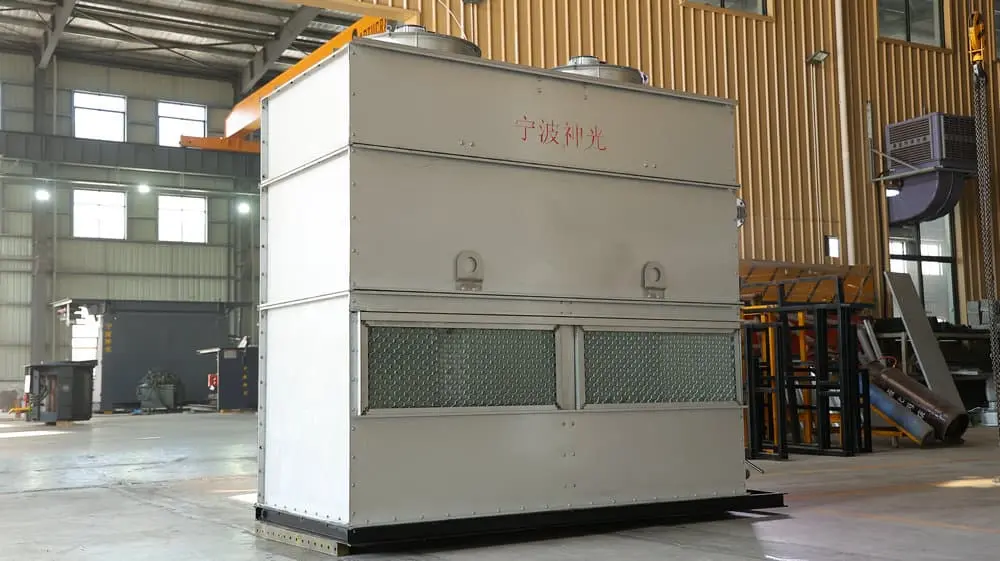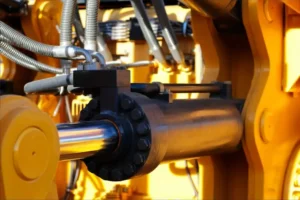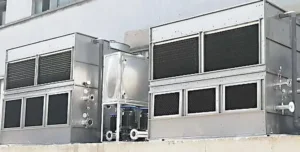
Закрытая градирня — важнейшая часть оборудования в промышленных условиях., responsible for managing temperature control in closed-loop systems efficiently. Unlike open cooling towers, which expose the cooling fluid directly to the environment, closed cooling towers use enclosed coils to circulate the cooling medium, isolating it from the air. This isolation brings several benefits in terms of energy efficiency, environmental protection, and durability. Below, we’ll explore how closed cooling towers operate and highlight the design features that maximize their performance and longevity.
1. Core Mechanism: Efficient Heat Exchange with Refrigeration Coils
At the heart of a closed cooling tower’s functionality is a set of high-efficiency refrigeration coils. These coils are designed with exceptional heat exchange efficiency, allowing the working fluid—typically water or a similar liquid—to pass through seamlessly. The cooling process is achieved in a single pass, minimizing energy consumption and enhancing the cooling performance.
As the working fluid flows through these coils, heat is transferred to the air circulated by fans over the coils, enabling natural heat exchange. This streamlined process means that the tower operates with minimal environmental impact, conserving energy while keeping the pipelines clean and unobstructed, thereby reducing the equipment’s failure rate and extending its service life.
2. Structural Integrity: Hot-Dip Galvanized Steel Construction
The closed cooling tower’s structure is built from hot-dip galvanized steel plates. This construction material is highly resistant to corrosion, ensuring that the equipment withstands varying environmental conditions. The tower’s design is also customizable, allowing customers to choose plate thicknesses and materials that meet their specific operational needs, enhancing its versatility and durability across diverse applications.
3. Advanced Three-Proof Fans for Continuous Operation
For reliable, uninterrupted cooling, closed cooling towers rely on high-performance, energy-efficient three-proof fans. These fans are engineered to support continuous, trouble-free operation 24/7. The use of advanced fans not only ensures adequate airflow over the coils but also significantly contributes to the system’s energy efficiency.
4. Precision-Controlled Refrigeration Coil and Stainless Steel Float Valve
The refrigeration coil itself is made from top-quality materials, selected to withstand the constant demands of industrial cooling. With a high heat exchange frequency, the coil optimally dissipates heat, ensuring consistent performance. Кроме того, a stainless steel float valve provides stable control over the spray liquid level. This component regulates the amount of cooling fluid in the system, preventing unnecessary water waste and enabling precise control over the cooling process.
5. Energy-Saving Water Pump and Efficient Water Collector
An energy-saving, large-flow water pump is integrated into the closed cooling tower’s design. This pump provides stable and efficient circulation of water through the system, minimizing power consumption while maximizing cooling efficacy. The closed tower is also equipped with a high-quality water collector, which helps reduce the drift rate—water loss through evaporation or splashing—making the system water-efficient and environmentally friendly.
6. Easy-to-Maintain Air Inlet Grille
The air inlet grille is designed with ease of maintenance in mind, allowing for quick disassembly and cleaning. This feature prevents spray water from splashing out and keeps sunlight from entering the water tank, which in turn prevents algae growth. Кроме того, the grille includes an air deceleration area, effectively guiding airflow towards the fan to enhance cooling performance.
7. Countercurrent Cooling for Low Drift Rate
Closed cooling towers use a countercurrent cooling method, where air and water flow in opposite directions, further enhancing cooling efficiency. This setup keeps the drift rate exceptionally low, conserving water and reducing operational costs.
8. Modular Heat Exchanger Design
A key feature of closed cooling towers is the modular design of their heat exchangers, which are built using a building-block stacking method. This modular structure allows the heat exchanger to be assembled or disassembled layer by layer, enabling easy maintenance and customization according to cooling requirements.
Advantages of Closed-Circuit Cooling Tower
The closed-loop system employed by closed cooling towers offers numerous advantages:
- Prevention of Blockages: The closed system prevents contaminants from entering the cooling fluid, reducing the risk of blockages and the need for frequent cleaning.
- Water and Energy Savings: The enclosed design significantly reduces water drift and evaporation, conserving both water and energy.
- Enhanced Equipment Longevity: Isolating the cooling fluid from contaminants in the air minimizes corrosion and scaling, helping the tower and connected equipment last longer.
- Environmental and Economic Benefits: Closed cooling towers operate with high efficiency, requiring less energy and water, which contributes to a smaller environmental footprint and lower operating costs.
Заключение
Closed cooling towers stand out as highly efficient, environmentally friendly solutions for industrial cooling. By incorporating advanced refrigeration coils, a robust galvanized steel structure, and energy-efficient components, these towers not only meet but exceed modern standards for performance and sustainability. Whether tailored to unique operational needs or running 24/7 without interruption, closed cooling towers provide a reliable solution that protects valuable equipment while conserving resources.







